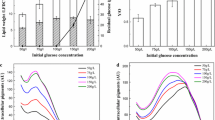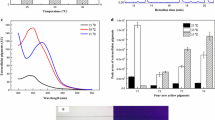Abstract
Nitrates can stimulate the biosynthesis of hydrophilic yellow pigments (HYPs) in Monascus ruber CGMCC 10910. To explore the molecular mechanisms whereby nitrates (NaNO3 and NH4NO3) regulate HYP production, an integrated transcriptomic and proteomic analysis was conducted in this study. Nitrate addition led to an approximately 75% higher HYP production compared with the untreated group, especially compounds Y3 and Y4. Comparative transcriptomic analysis found that mpigsA, H, K, L, and P genes involved in yellow pigment biosynthesis were significantly upregulated. In addition, pigment biosynthesis-related (carbon catabolism, amino acid metabolism, polyketide synthesis, and fatty acid metabolism) genes were upregulated to provide precursors and energy for HYP biosynthesis and cell growth. Secretion-related (cytomembrane ergosterol biosynthetic, and transport) pathways were also noticeably regulated to accelerate transmembrane transport of HYPs. Meanwhile, proteomic analysis showed that nitrates improved the protein expression of hybrid polyketide synthase-nonribosomal peptide synthetase, oxidoreductase, glucoamylase, endo-1,4-beta-xylanase, O-acetylhomoserine, and isocitrate lyase to enhance HYP production. These findings demonstrated the regulatory mechanism of nitrates for enhancing HYP production in Monascus.
Key points
• Nitrates stimulated the biosynthesis of Monascus hydrophilic yellow pigments (HYPs)
• Nitrates affected transcriptional level of pigment biosynthesis- and transport genes
• Increased expression of hybrid PKS-NRPS and transporters promoted production of HYPs





Similar content being viewed by others
Data availability
All data generated or analyzed during this study are included in this published article and its supplementary material files.
References
Ashburner M, Ball CA, Blake JA, Botstein D, Butler H, Cherry JM, Davis AP, Dolinski K, Dwight SS, Eppig JT, Harris MA, Hill DP, Issel-Tarver L, Kasarskis A, Lewis S, Matese JC, Richardson JE, Ringwald M, Rubin GM, Sherlock G (2000) Gene ontology, tool for the unification of biology. Nat Genet 25:25–29
Bai J, Gong Z-H, Shu M, Zhao H, Ye F-Y, Tang C-L, Zhang S, Zhou B, Lu D, Zhou X, Lin Q-L, Liu J (2022) Increased water-soluble yellow Monascus pigment productivity via dual mutagenesis and submerged repeated-batch fermentation of Monascus purpureus. Front Microbiol 13:914828
Balakrishnan B, Chandran R, Park S-H, Kwon H-J (2015) A new protein factor in the product formation of non-reducing fungal polyketide synthase with a C-terminus reductive domain. J Microbiol Biotechnol 25:1648–1652
Chen G, Wu Z-Q (2016) Production and biological activities of yellow pigments from Monascus fungi. World J Microb Biot 32:136
Chen D, Chen M, Wu S, Li Z, Yang H, Wang C (2017a) The molecular mechanisms of Monascus purpureus M9 responses to blue light based on the transcriptome analysis. Sci Rep 7:5537
Chen W-P, Chen R-F, Liu Q-P, He Y, He K, Ding X-L, Kang L-J, Guo X-X, Xie N-N, Zhou Y-X, Lu Y-Y, Cox RJ, Molnar I, Li M, Shao Y-C, Chen F-S (2017b) Orange, red, yellow, biosynthesis of azaphilone pigments in Monascus fungi. Chem Sci 8:4917–4925
Chen W-P, Feng Y-L, Molnar I, Chen F-S (2019) Nature and nurture, confluence of pathway determinism with metabolic and chemical serendipity diversifies Monascus azaphilone pigments. Nat Prod Rep 36:561–572
Ermakova E, Zuev Y (2017) Effect of ergosterol on the fungal membrane properties. All-atom and coarse-grained molecular dynamics study. Chem Phys Lipids 209:45–53
He J-T, Jia M-X, Li W, Deng J, Ren J-L, Luo F-J, Bai J, Liu J (2021) Toward improvements for enhancement the productivity and color value of Monascus pigments, a critical review with recent updates. Crit Rev Food Sci 62:7139–7153
Hong J-L, Wu L, Lu J-Q, Zhou W-B, Cao Y-J, Lv W-L, Liu B, Rao P-F, Ni L, Lv X-C (2020) Comparative transcriptomic analysis reveals the regulatory effects of inorganic nitrogen on the biosynthesis of Monascus pigments and citrinin. RSC Adv 10:5268–5282
Huang T, Wang M-H, Shi K, Chen G, Tian X-F, Wu Z-Q (2017) Metabolism and secretion of yellow pigment under high glucose stress with Monascus ruber. AMB Expr 7:79
Huang Z-R, Zhou W-B, Yang X-L, Tong A-J, Hong J-L, Guo W-L, Li T-T, Jia R-B, Pan Y-Y, Lin J, Lv X-C, Liu B (2018) The regulation mechanisms of soluble starch and glycerol for production of azaphilone pigments in Monascus purpureus FAFU618 as revealed by comparative proteomic and transcriptional analyses. Food Res Int 106:626–635
Huang D, Wang Y-H, Zhang J, Xu H-M, Bai J, Zhang H-J, Jiang X-L, Yuan J, Lu G-G, Jiang L-Y, Liao X-P, Liu B, Liu H-H (2021a) Integrative metabolomic and transcriptomic analyses uncover metabolic alterations and pigment diversity in Monascus in response to different nitrogen sources. Msystems 6:e00807-e821
Huang Z-F, Yang S-Z, Liu H-Q, Tian X-F, Wu Z-Q (2021b) Sodium starch octenyl succinate facilitated the production of water-soluble yellow pigments in Monascus ruber fermentation. Appl Microbiol Biotechnol 105:6691–6706
Huang Z-F, Hu T-T, Liu H-Q, Xie H-X, Tian X-F, Wu Z-Q (2022) Biosynthesis and polyketide oxidation of Monascus red pigments in an integrated fermentation system with microparticles and surfactants. Food Chem 394:133545
Jian J, Wei W, Yin G, Hettinghouse A, Liu C, Shi Y (2018) RNA-Seq analysis of interferon inducible P204-mediated network in anti-tumor immunity. Sci Rep 8:6495
Li Y-P, Tang X, Wu W, Xu Y, Huang Z-B, He Q-H (2015) The ctnG gene encodes carbonic anhydrase involved in mycotoxin citrinin biosynthesis from Monascus aurantiacus. Food Addit Contam A 32:577–583
Li Y-P, Wang N, Jiao X-X, Tu Z, He Q-H, Fu J-H (2020) The ctnF gene is involved in citrinin and pigment synthesis in Monascus aurantiacus. J Basic Microb 60:873–881
Liang B, Du X-J, Li P, Sun C-C, Wang S (2018) MptriA, an acetyltransferase gene involved in pigment biosynthesis in M. purpureus YY-1. J Agric Food Chem 66:4129–4138
Lin Y-L, Wang T-H, Lee M-H, Su N-W (2008) Biologically active components and nutraceuticals in the Monascus-fermented rice, A review. Appl Microbiol Biot 77:965–973
Liu J, Chai X, Guo T, Wu J, Yang P, Luo Y, Zhao H, Zhao W, Nkechi O, Dong J, Bai J, Ling Q (2019) Disruption of the ergosterol biosynthetic pathway results in increased membrane permeability, causing overproduction and secretion of extracellular Monascus pigments in submerged fermentation. J Agric Food Chem 67:13673–13683
Liu J-J, Wu J-Y, Cai X-R, Zhang S, Liang Y, Lin Q-L (2021) Regulation of secondary metabolite biosynthesis in Monascus purpureus via cofactor metabolic engineering strategies. Food Microbiol 95:103689
Long C-N, Liu M-M, Chen X, Wang X-F, Ai M-Q, Cui J-J, Zeng B (2018) The acyl-CoA binding protein affects Monascus pigment production in Monascus ruber CICC41233. Biotechnol 8:121
Ouyang W-B, Liu X, Wang Y-L, Huang Z-B, Li X-J (2021) Addition of genistein to the fermentation process reduces citrinin production by Monascus via changes at the transcription level. Food Chem 343:128410
Qian G-F, Huang J, Farhadi A, Zhang B-B (2021) Ethanol addition elevates cell respiratory activity and causes overproduction of natural yellow pigments in submerged fermentation of Monascus purpureus. LWT-Food Sci Technol 139:110534
Ramzan R, Virk MS, Chen F-S (2022) The ABCT31 transporter regulates the export system of phenylacetic acid as a side-chain precursor of penicillin G in Monascus ruber M7. Front Microbiol 13:915721
Shi K, Song D, Chen G, Pistolozzi M, Wu Z, Quan L (2015) Controlling composition and color characteristics of Monascus pigments by pH and nitrogen sources in submerged fermentation. J Biosci Bioeng 120:145–154
Suh JW, Bijinu B, Lim YJ, Doh Won L, Choi JJ, Park SH, Kwon HJ (2018) Production of a hypothetical polyene substance by activating a cryptic fungal PKS-NRPS hybrid gene in Monascus purpureus. J Appl Biol Chem 61:83–91
Wang B, Zhang X-H, Wu Z-Q, Wang Z-L (2015) Investigation of relationship between lipid and Monascus pigment accumulation by extractive fermentation. J Biotechnol 212:167–173
Wang M-H, Huang T, Chen G, Wu Z-Q (2017) Production of water-soluble yellow pigments via high glucose stress fermentation of Monascus ruber CGMCC 10910. Appl Microbiol Biotechnol 101:3121–3130
Xie C, Mao X, Huang J, Ding Y, Wu J, Dong S, Kong L, Gao G, Li C-Y, Wei L (2011) KOBAS 2.0, a web server for annotation and identification of enriched pathways and diseases. Nucleic Acids Res 39:316–322
Xu G-B, Li J-G, Liu Q, Sun W-L, Jiang M, Tian C-G (2018) Transcriptional analysis of Myceliophthora thermophila on soluble starch and role of regulator AmyR on polysaccharide degradation. Bioresour Technol 265:558–562
Yang H, Li J, Wang Y, Gan C (2018) Identification of water-soluble Monascus yellow pigments using HPLC-PAD-ELSD, high-resolution ESI-MS, and MS-MS. Food Chem 245:536–541
Yang S, Huang Z, Liu H-Q, Hu X, Wu Z-Q (2020) Improving mycelial morphology and adherent growth as well as metabolism of Monascus yellow pigments using nitrate resources. Appl Microbiol Biotechnol 104:9607–9617
Ye J, Lin X, Cheng Z, Su Y, Li W, Ali F, Zheng J, Peng B (2018) Identification and efficacy of glycine, serine and threonine metabolism in potentiating kanamycin-mediated killing of Edwardsiella piscicida. J Proteom 183:34–44
Zhang J, Liu Y, Li L (2018) Gao M (2018) ITRAQ-based quantitative proteomic analysis reveals changes in metabolite biosynthesis in Monascus purpureus in response to a low-frequency magnetic field. Toxins 10:440
Zhang J, Li Q-R, Liu J-H, Lu Y-H, Wang Y, Wang Y-H (2020) Astaxanthin overproduction and proteomic analysis of Phaffia rhodozyma under the oxidative stress induced by TiO2. Bioresour Technol 311:123525
Zhou B, Wang Y, Lu H-M, Zhou Y-Q (2015) Effect of ammonium salts on pigments production by Monascus anka mutant in 5L bioreactor. Chiang Mai J Sci 41:1032–1043
Zhou W-B, Rui G, Guo W-L, Hong J-L, Li L, Sun J, Liu B, Rao P-F, Lv X-C (2019) Monascus yellow, red and orange pigments from red yeast rice ameliorate lipid metabolic disorders and gut microbiota dysbiosis in Wistar rats fed on a high-fat diet. Food Funct 10:1073–1084
Funding
This study was financially supported by Guangdong Key R&D Program, Department of Science and Technology of Guangdong Province (2019B040402002 and 2019B020210002), and Guangdong Special Funds for Science and Technology Innovation Strategy, China (2018JK35202003).
Author information
Authors and Affiliations
Contributions
SZY and ZFH designed and carried out the experiments, analyzed the data, and wrote the manuscript; ZFH, TTH, and SZY assisted to carry out the experiment; XFT and ZQW participated in the data analysis and finalized the manuscript. All authors read and approved the final manuscript.
Corresponding author
Ethics declarations
Ethics approval
This article does not contain any studies with human participants or animals performed by any of the authors.
Conflict of interest
The authors declare they have no competing interests.
Additional information
Publisher's note
Springer Nature remains neutral with regard to jurisdictional claims in published maps and institutional affiliations.
Supplementary information
Below is the link to the electronic supplementary material.
Rights and permissions
Springer Nature or its licensor (e.g. a society or other partner) holds exclusive rights to this article under a publishing agreement with the author(s) or other rightsholder(s); author self-archiving of the accepted manuscript version of this article is solely governed by the terms of such publishing agreement and applicable law.
About this article
Cite this article
Huang, Z., Hu, T., Yang, S. et al. Genetic responses to adding nitrates to improve hydrophilic yellow pigment in Monascus fermentation. Appl Microbiol Biotechnol 107, 1341–1359 (2023). https://doi.org/10.1007/s00253-023-12392-9
Received:
Revised:
Accepted:
Published:
Issue Date:
DOI: https://doi.org/10.1007/s00253-023-12392-9




